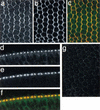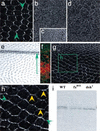Unipolar membrane association of Dishevelled mediates Frizzled planar cell polarity signaling
- PMID: 11358862
- PMCID: PMC313798
- DOI: 10.1101/gad.890501
Unipolar membrane association of Dishevelled mediates Frizzled planar cell polarity signaling
Abstract
Drosophila epithelia acquire a planar cell polarity (PCP) orthogonal to their apical-basal axes. Frizzled (Fz) is the receptor for the PCP signal, and Dishevelled (Dsh) transduces the signal. Here, I demonstrate that unipolar relocalization of Dsh to the membrane is required to mediate PCP, but not Wingless (Wg) signaling. Dsh membrane localization reflects the activation of Fz/PCP signaling, revealing that the initially symmetric signal evolves to one that displays unipolar asymmetry, specifying the cells' ultimate polarity. This transition from symmetric to asymmetric Dsh localization requires Dsh function, and reflects an amplification process that generates a steep intracellular activity gradient necessary to determine PCP.
Figures




References
-
- Adler PN, Charlton J, Jones KH, Liu J. The cold-sensitive period for frizzled in the development of wing hair polarity ends prior to the start of hair morphogenesis. Mech Dev. 1994a;46:101–107. - PubMed
-
- Adler PN, Krasnow RE, Liu J. Tissue polarity points from cells that have higher Frizzled levels towards cells that have lower Frizzled levels. Curr Biol. 1997;7:940–949. - PubMed
-
- Bhat KM. frizzled and frizzled 2 play a partially redundant role in wingless signaling and have similar requirements to wingless in neurogenesis. Cell. 1998;95:1027–1036. - PubMed
Publication types
MeSH terms
Substances
Grants and funding
LinkOut - more resources
Full Text Sources
Other Literature Sources
Molecular Biology Databases
